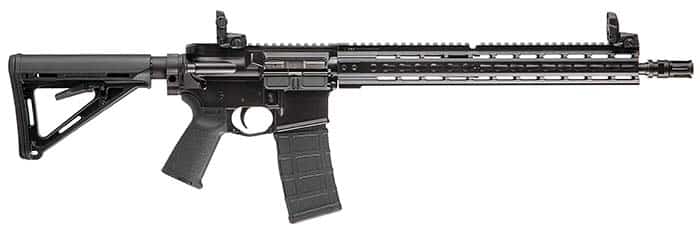Right side of the .223 Wylde caliber Mk116. Notice the Magpul MOE pistol grip, stock and back-up sights.
By Christopher R. Bartocci
At this time, most of the major black rifle manufacturers offer their own external piston rifle and most all of them are short stroke tappet designs with the piston and operating rod separate from the bolt carrier. Only a couple manufacturers have gone with the long stroke piston, which is where the operating rod and piston are connected to the bolt carrier group as one piece. The most successful two companies making long stroke piston rifles are ADCOR Defense and Primary Weapon Systems.
Primary Weapon Systems (PWS) began in 2005 as AK Concepts and in 2008 they formed a new company called Primary Weapon Systems. The founder and President, Dean Sylvester, is also the lead designer of all PWS products. The early company AK Concepts, manufactured collector grade Yugoslavian variant AK-47s. The first product from that was the JTAC47 muzzle brake for the AK-47 that is still in production today. The new company, PWS, first started selling long stroke piston operated AR rifles in 2009. The Mod1 systems were released in 2013.
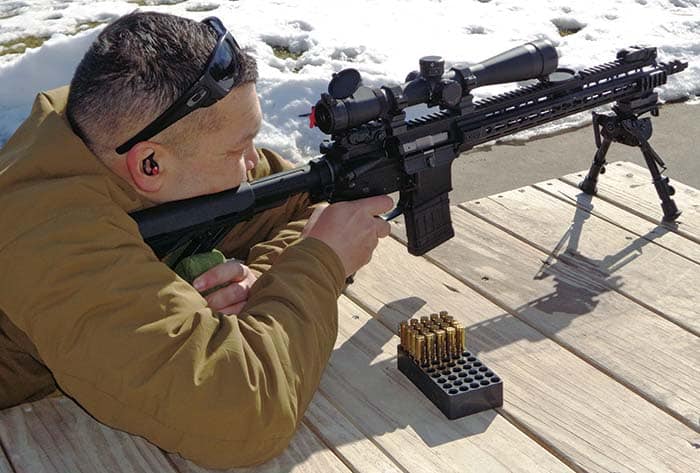
The AR-15/M16/M4 family of weapons is not designed to be an external piston operated firearm. The in-line construction is designed so the barrel, bolt carrier and stock are in perfect alignment and the action goes straight back into the receiver extension. This is a major contributor of the smoothness and reliability of the system. When one adds a short stroke tappet operating system into the rifle, the operation rod strikes the bolt carrier tipping the bolt carrier off center. This creates bolt carrier tilt where the bottom edge of the rear of the bolt carrier scrapes the receiver extension. Early designs showed this would dig into the receiver extension and if left alone the carrier could go through the receiver extension. The common fix is to add skis to the back of the bolt to prevent this. Another issue to arise is excessive cyclic rate. To reliably operate the heavier components that make up the operating system, more gas is required. This accelerates two things. First it accelerates wear on the bolt and fire control group and, secondly, the upper receiver, inside behind the cam slot, the cam pin digs a trench into the receiver from the bounce of the carrier striking the barrel extension. Rifles with an external piston mechanism are designed so the bolt carrier group rides on rails to keep it centered. So when the piston is driven rearward the bolt carrier rides rearward on the rails keeping the bolt in line with the chamber. Looking at the AK-47 system is a clear example of this. With the AR-type system the bolt carrier rides freely without rails – again designed to be inline. The benefit of the long stroke piston over the short stroke tappet is that the attached operating rod keeps the bolt carrier group straight; there is no tipping due to the operating rod striking the top of the bolt carrier.
The concept behind the PWS design is quite simply to put the AK-47 gas system into the AR platform. PWS claims that the AK-type long stroke piston mechanism (no extra parts, springs, etc.) offers a smoother push instead of a short violent push of the short stroke tappet system (no metal-to-metal impact/no short punchy recoil) simply made the most sense when they looked at everything else that was out on the market. The idea is to have the familiar AR rifle with the added reliability of the AK-47 system: meaning cleaner, less heat in the receiver and brutal reliability. The PWS mechanism is rather quite simple. The bolt carrier has the operating rod attached to it. Depending upon the length of the gas system an additional rod is clamped over the end of the operating rod. The gas block is adjustable with four different positions to facilitate use of various types of ammunition and use of a sound suppressor. As PWS designed the system, no tools are required to disassemble the rifle/gas system for cleaning. Contrary to what some believe, external piston mechanisms do need to be cleaned. Carbon, copper and powder fouling can seize the piston into the gas block making for extreme difficulty in pulling back the bolt carrier group or worse, cause the rifle to short stroke when fired due to the piston/operating rod being stuck in the gas regulator. One very important feature that PWS has added to their rifle that many of their competition are missing is an operating rod sleeve. This sleeve protects the operating rod and piston from the elements (other than carbon). During extreme conditions, if no protection sleeve is present, the dirt, sand, mud or any other debris can find its way into the rail and then onto the rod and it can work its way into the mechanism. Although a very simple concept, many manufacturers of the external pistol (short stroke tappet or long stroke) fail to add this important feature, which really amounts to a hollow tube.
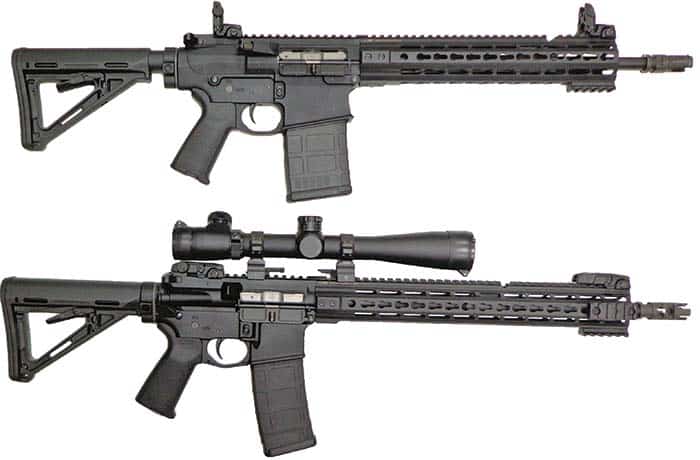
PWS manufactures a significant number of parts for their weapons and unlike most manufactures the key components are all made in-house. With the exception of lower receiver parts kits, Magpul furniture and VLTOR Gunfighter charging handle, PWS have the ability to manufacture every part of the rifle in house. PWS does bring in some components from outside vendors due to volume needed, but they are heavily quality controlled before they reach the production floor. They manufacture a variety of configurations and barrel lengths. The MK107 has a 7.75 inch barrel, MK110 has a 10.75 inch barrel, MK112 has a 12 inch barrel, MK114 has a 14.5 inch barrel, MK116 has a 16 inch barrel and the MK118 has an 18 inch barrel. There were two T&E rifles sent – both MK116 rifles – one chambered in .223 Wylde and the other chambered in .300 AAC Blackout. Both rifles are virtually identical except the .300 Blackout uses a shorter 4-inch gas system instead of the 7-inch. Due to the pressure curve of the Blackout cartridge this is the most reliable option; particularly due to the use of both supersonic and subsonic ammunition. As of this writing, PWS is one of the very few manufactures who use an external piston system for the .300 Blackout cartridge. Most everyone uses the direct gas system.
Starting at the rear of the rifle, the rifle is equipped with a Magpul MOE stock. This is a very comfortable stock with a rubber butt pad for non slip on the shooter’s shoulder. The receiver extension is manufactured by PWS and is called the EBT Carbine Buffer System. This system eliminates the need for the receiver extension nut. There is an indexing screw in place of the receiver extension nut that ensures proper alignment. There is a receiver extension end plate that has two quick detach sling swivel attachments for ambidextrous use. The receiver extension is manufactured from a 6061 A1 extrusion with external flutes to allow debris to be pushed out of the way. The receiver extension permits five positions along with four extra-large drain holes. The rifle uses a PWS H2 buffer, which is two stainless steel weights along with
one tungsten weight.

The lower receiver is a basic Mil-Spec lower receiver that is manufactured from 7075 T6 aircraft grade aluminum and black anodized hard coated. The pistol grip is the very comfortable Magpul MOE and additionally the lower uses the Magpul polymer enhanced trigger guard. The safety, bolt catch and magazine catch are Mil-Spec. The trigger group is also standard Mil-Spec. Most customers will customize their rifles including adding the trigger of their choice. The trigger on the .223 Wylde rifle broke at 7 pounds. The trigger pull was decent; little creep but very respectable for a standard group.
The charging handle for the MK116 is the VLTOR Gunfighter charging handle. This charging handle is machined from a billet and uses the medium size latch. What is unique about this design is that unlike the standard charging handle where all of the pressure goes on that tiny roll pin when the charging handle is pulled back, the Gunfighter transfers all pressure right to the charging handle itself. This makes for an extremely durable charging handle that you would really be hard pressed to break.

The bolt carrier has additional mass on it compared to a standard DI carrier to delay unlocking. Looking at the bolt carrier/operating rod group, all the components minus the firing pin retainer pin and the firing pin are Nickel-Teflon coated for ease of cleaning and this finish is more tolerant of lack of lubrication. The bolt carrier is selective fire so it may be used in a selective fire lower receiver. The bolt carrier is manufactured by PWS. The rear of the carrier has two ridges on the rear as well as some “crud” grooves in the right and left side. The operating rod is attached by a groove in the operating rod and a slot in the top of the carrier. Then the operating rod is secured by two screws and the screws are staked into the operating rod rather than the carrier by being staked into the screws of the standard direct gas rifles. The bolt is manufactured by PWS as well. The front portion of the bolt with the locking lugs is standard Mil-Spec but the rear has been modified; the gas ring area has been ground down since gas rings are not needed. The bolt is nickel-Teflon coated as well as the extractor. The extractor has the rubber “O” ring on it to assist extraction by increasing the extraction force by a factor of 4. On the back of the bolt, a spring is attached aiding in assembly of the bolt carrier group by holding the bolt in the unlocked position. The cam pin is also nickel-Teflon coated. The firing pin is the standard Mil-Spec chrome plated firing pin. The piston head is attached without tools. In the case of the .223 Wylde the piston shaft is 3 3/4 inches in length and in the case of the .300 Blackout with the pistol length gas system, the piston is approximately 1-inch long.
The gas block is placed on the barrel and held on by a nut that is screwed onto the barrel in front of the gas block. Then the nut is staked in place. There is a piston tube to protect the operating rod from debris and fouling. The 4-position adjustable plug allows for positions for normal conditions, hotter military loads, suppressed and suppressed with hotter military ammunition. The plug is then removed by placing on the X positions. There is a spring loaded detent that pushes the plug out of the gas block. There is a slot cut in the top of the rail that gives the user access to the gas plug so the user can make adjustments and clearly see the pictogram of what setting the plug is on. The gas path is rather interesting. There is a straight 90° port out of the barrel, then there is another port hole drilled into the gas block that moved the gas forward to prevent fouling.
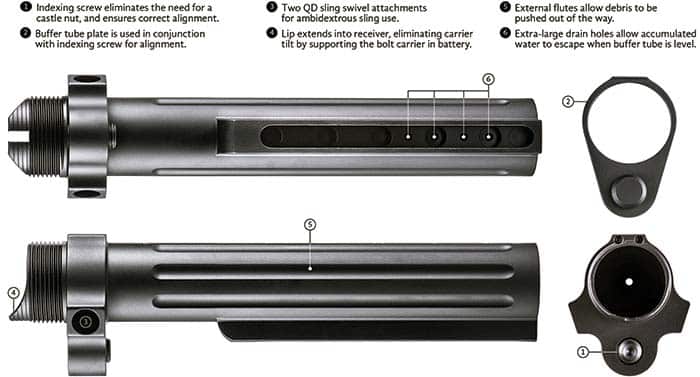
Both the .223 Wylde and .300 Blackout barrels were 16 inches in length. The .223 Wylde has a 1 turn in 8 twist with 6 lands and grooves. The .300 Blackout is also 1 turn in 8 inches. The 4140 steel barrels are Bergar button rifled blanks and PWS turns, profiles and chambers them in-house. PWS does a salt bath nitride coating that gets on the outside as well as inside of the barrel. This process has proven to PWS to not have the inconsistencies of chrome without losing any of the hardness. PWS manufactures their own barrel extensions.
The .300 Blackout rifle was equipped with the PWS Triad flash suppressor. There are elongated cuts between the tines to keep the muzzle rise to the absolute minimum and the tine shape prevents the venerable “pinging” associated with many other prong-type flash suppressors. The shape of the Triad allows installation of the Gemtech Halo sound suppressor. The .223 Wylde MK116 was equipped with a FSC556, the flagship of the PWS muzzle devices. This is basically a flash suppressing compensator. There is a quad-tine pattern that suppresses flash with a design to keep flash out of your line of sight and the unique shape provides recoil compensation. This flash suppressor/compensator is a very popular original equipment manufacturer product including the FNUSA SCAR16 and 17, Barrett, Core15 and AWC. Both of these flash suppressors/compensators are offered for both .223 and .308 caliber rifles. Additional models are available for the AK-47 as well as one compatible with the QDSS-NT 4 suppressor. PWS also offers just compensator models for the AK-47: an extremely short compensator (1.87 in), CQB (eliminates as much flash as possible and send the report forward of the shooter) and a precision compensator designed to reduce felt recoil in firearms from .223 to .338 caliber.

The T&E rifles were equipped with PWS designed and manufactured Keymod handguards. These rail systems are offered in both 12 and 15 inches in length and are manufactured from 6061 T6 aluminum extrusions. They are attached to a proprietary barrel nut by six hex screws. The Keymod interface permits attachment of rail panel segments enabling the user to only put on a rail that is needed. This cuts down on unnecessary weight as well as having unused rail that could be damaged in rough handling not permitting their future use. The rail is very narrow and easy to hold. When holding the rail by hand, it will heat up very fast requiring the use of gloves. PWS also offers this rail in a direct gas model enabling any Mil-Spec AR to be upgraded with the PWS Keymod rail.
The T&E rifles each came in a polymer case with one Magpul Gen 2 PMag. The ammunition used to test fire the .223 Wylde rifle was Federal American Eagle 62 grain full metal jacket (AE223N), Black Hills Ammunition Mk262 Mod1 77grain open tip match and Double Tap 80gr boat tail match (22380M20) ammunition. The rifle was tested with Magpul PMag Gen 2 and 3, Lancer AWM, Hera H3, H&K high reliability/polymer magazine and Surefire 60 round magazine. No lubrication was added to the rifle prior to firing. More than 400 rounds of ammunition were fired through the test rifle with no malfunctions of any sort. The muzzle brake was quite effective if you are the shooter, not so much if you are on the side of the shooter – the blast was quite loud. The rifle functioned properly with all the magazines. The rifle did not like the Doubletap Ammunition 80gr HPBT as the rifle would not get a consistent group. However, it did like the Doubletap 62gr FMJ giving constant 1.6 MOA groups at 100 yards. The rifle scored best with the Black Hills Mk262 Mod1 ammunition giving a 10 shot group of 1.2 inches at 100 yards. It should be noted that the wind was 18 to 22 mph when the rifle was tested. This could have been a factor in the group size. The trigger pull was also a factor as the heavy Mil-Spec trigger was difficult for precision work. Perhaps if a decent match trigger was installed, that could cause that group to tighten up. Recoil was noticeably more on the long stroke piston operated PWS rifle than the Mega Arms direct gas rifle we also had out at the range.
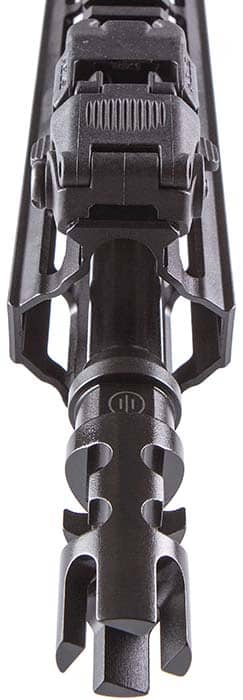
Flagship PWS FSC556 muzzle devices. This is basically a flash suppressing compensator.
The .300 Blackout rifle was tested with the Magpul PMag Gen 2 and the Lancer AWM magazine. The ammunition tested was the Remington 125gr OTM (RM300AAC6), Remington UMC 115gr CTFB (L300AAC2), Hornady Custom 110gr V-Max (#8089) and Barnes 110gr TAC-TX (90014). No lubrication was added to the rifle prior to firing. There were a total of 200 rounds fired with no malfunctions. It should be noted that the rifle even cycled 20 rounds of Hornady 208gr subsonic with no malfunctions. This was the only subsonic ammunition available at this time for testing. Recoil was decent and reliability absolute. This was the first long stroke or short stroke piston rifle chambered in .300 Blackout this author has fired. Most of the known external piston manufacturers have stayed away from this but PWS made it work and work well. It has been certainly well established the benefits of the pistol length gas system for this caliber. Much of the shooting with this rifle was done off hand and at a steel plate at 100 yards. Once the rifle was zeroed, the steel was pinging from one shot to the next. The rifle was then fired off of a bench with Remington 125gr OTM (RM300AAC6) with the best group of .860 inches at 52 yards.
Like most in the industry, PWS makes a 7.62x51mm rifle to complete their family of weapons; this is known as the MK2-series. The MK212 has a 12.75 inch barrel, the MK214 has a 14.5 inch barrel, the MK216 has a 16 inch barrel and the MK220 has a 20 inch barrel. Whether the operator wishes for a short CQB rifle or a DMR rifle, PWS has what they would need.
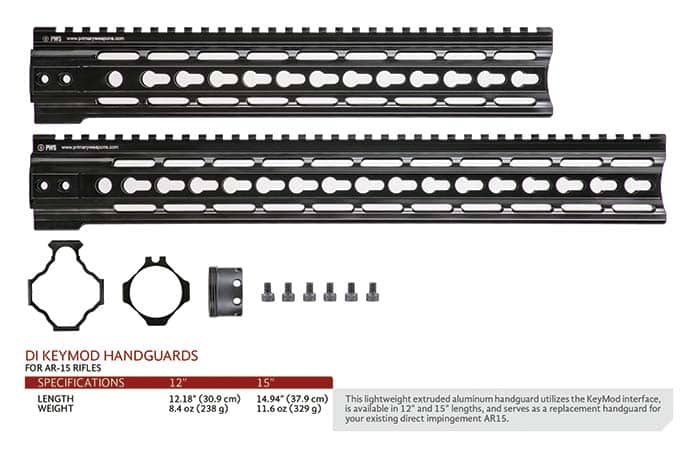
The rifle received for test and evaluation was a MK214 chambered in 7.62x51mm. This rifle has a 14.5 inch barrel with a 2.20 inch Triad 30 flash suppressor pinned to the end of the barrel to make the barrel reach the 16 inch + inches rendering it legal. This is the shortest non-NFA rifle in the PWS MK2 line up. Unloaded, the rifle weighs 8 lbs., 8.9 oz. The short barrel still retains an effective range of 700 yards using various types of ammunition.
The lower receiver is manufactured from a billet of 7075 T6 aircraft aluminum. The lower receiver has the Magpul MOE pistol grip. The PWS EBT receiver extension is used along with a Magpul MOE stock. The EBT used for the MK2 is slightly longer than that of one designed for a 5.56mm rifle to allow the use of a AR-15 carbine buffer instead of the shorter .308 carbine buffer. The weight of the buffer for the MK2 rifle is equivalent to that of a H2 buffer. In the grip insert of the MOE pistol grip is a gas block adjustment tool. This particular rifle was equipped with an ALG Defense QMS or Quality Mil-Spec trigger group. The trigger broke at 6.25 pounds and was quite smooth. The magazine catch and bolt catch are standard AR-type. The trigger guard is part of the lower receiver and is enlarged to accept gloved hands. In front of the magazine well are two chevron shaped grooves to assist with grip. The rifle uses the standard SR-25 magazine and was provided with a Magpul PMag 20LR. The rifle was tested with both the Knights Armament and CProducts steel magazines as well.

The upper receiver is manufactured from a billet of 7075 T6 aluminum and incorporates a combination forward assist and fired cartridge case deflector in the same manner as the DPMS .308 Win-family of weapons. The rifle sent for test and evaluation is the MK216 rifle. Like the MK116, the MK216 also uses the Keymod free floating rail system. The Magpul polymer MBus folding backup sight come standard on the rifle.
The barrel is again 14.5 inches and is button rifled from 4140 Chromoly steel with a 1 turn in 10 inch twist. At the end of the barrel is a 2.20 inch Triad 30 flash suppressor pinned in place. This barrel is an Isonite QPQ treated barrel. Primary Weapon Systems estimate a minimum barrel life of 9,000 rounds if routinely maintained (bore and chamber cleaned every 1,000 rounds and bolt carrier group disassembled and cleaned every 3 to 4,000 rounds). There is, like the MK1 series, a 4-position adjustable gas valve accessible through a cut-out in the front portion of the Primary Weapon Systems Keymod rail. The Keymod rail is manufactured from an extrusion of 6061T aluminum. Sent along with this rifle is the PWS Keymod polymer Harris bipod adapter as well as a 2.16 inch polymer rail segment. These rail segments are offered in aluminum as well. The maximum effective range is based off of the barrel length. The 12 inch is 600 yards, the 14.5 inch barrel is 700 yards, the 16 inch barrel is 800 yards and the 20 inch barrel is 1,000 yards.
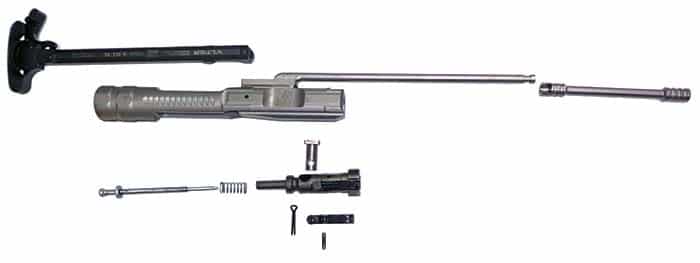
The MK2 barrel is also equipped with the Primary Weapon System adjustable gas block that allows the shooter to balance the gas system giving just enough gas to properly cycle the weapon, no more. This decreases felt recoil and extends the service of several key rifle components. Position 1 is normal operation with standard and some military ammo. Position 2 is for hotter military loads. Position 3 is for use with a sound suppressor with standard ammunition and position 4 is for use with a sound suppressor and hotter military ammunition. The X position is for disassembly, removing the gas plug from the front sight base.
Both the upper, lower receiver, bolt carrier group and barrel are not compatible with any factory standard out in the industry. The upper receiver cannot be placed on any other lower. The PWS MK2 is designed as a complete weapon only.
The MK2 nickel Teflon coated bolt carrier group is really just the MK1 series on steroids. The bolt is a dedicated bolt with the gas ring location machined off. Unlike the MK1 series there is no spring on the tail of the bolt. All this means is you have to pay a little more attention during the assembly process to insure the bolt is in the unlocked position when installing it into the upper receiver. The bolt carrier does appear to be heavier than the standard AR10-type with the same geometry as the MK1. The bolt carrier group is manufactured by Primary Weapon Systems.
The ammunition used for testing the MK214 was Black Hills Ammunition 7.62mm 175gr M118LR ammunition as well as Federal XM80 ball ammunition. This rifle appears not to be sensitive to ammunition. The optic chose to test the rifle with is the Leupold Mark 4 LR/T 3.5-10x40mm M3 Illum (67950) optic. Groups averaged at just around 1 inch at 52 yards.
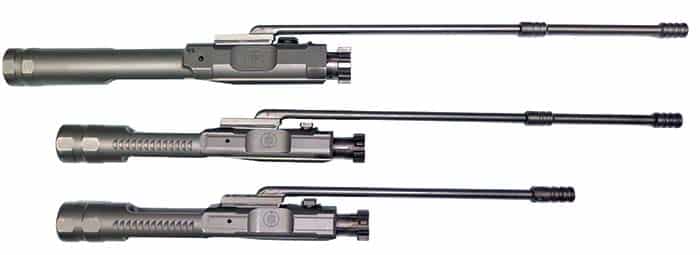
PWS offers their own direct gas bolt carrier upgrade to consumers based on their MK1. The enhanced bolt carrier requires less lubricant, increased surface hardness and slickness. The pores of the tool steel are sealed on either the Isonite QPQ or nickel Teflon carriers. The nickel Teflon is a running change in production in 2014. PWS feels it gives their rifles a more “broken in” feel when brand new. The carrier has slabbed sides and brought in the surfaces where they did not want the carrier to touch the inside of the upper receiver and extended the surfaces out that they did want the carrier to touch the inside of the upper receiver. The end result is less bearing surface, but the carrier rides inside the receiver with less slop and in return you get a smoother cycling of the system. This same philosophy holds true to the direct gas as well as their piston operated carriers. The carrier also has a heavier weight than normal that aids in longer dwell time, which means it allows for the cartridge case to contract more prior to the initiation of extraction. The less residual pressure the easier it is to extract the fired cartridge case. This can be very useful in short barreled suppressed rifles (10.5 and 14.5-inch barrels).
For the direct gas shooters, PWS offered Direct Impingement Keymod handguards as well. This handguard is offered in both 12 and 15 inch lengths. The lightweight rails weigh 8.4 oz for the 12 and 11.6 oz for the 15 inch Keymod rail. The kit is comprised of a Keymod rail, trunion, Neodymium magnet, barrel nut, barrel nut wrench and 6 hex screws. The only tools required for installation are a 9/64, 3/32 inch hex wrenches and 1/2 inch torque wrench. The rail is quite slim and lightweight and not difficult to assemble.
The PWS family of weapons differs from the others in its use of the long stroke gas system rather than the more common short stroke. All three weapons tested were 100% reliable. The recoil impulse was a little more stout than any other AR-type rifle this author has shot. The carrier/operating rod is a much larger mass than that used on a short stroke tappet rifle which explains the heavier recoil. This would be greatly useful in a condition where the rifle is in extremely adverse conditions. The PWS system fills a niche for those who may seek this type of reliability. The fit and finish of the PWS rifles is excellent and the rifles are extremely well made. The company manufactures many of their own components, which is always a significant plus in maintaining consistent reliability. The design approach that PWS took has only been used by ADCOR in their BEAR carbine. However, very few of these rifles exist in the market place so they are pretty much the only game in town using the true AK long stroke system in an AR platform.
| This article first appeared in Small Arms Review V19N10 (December 2015) |



